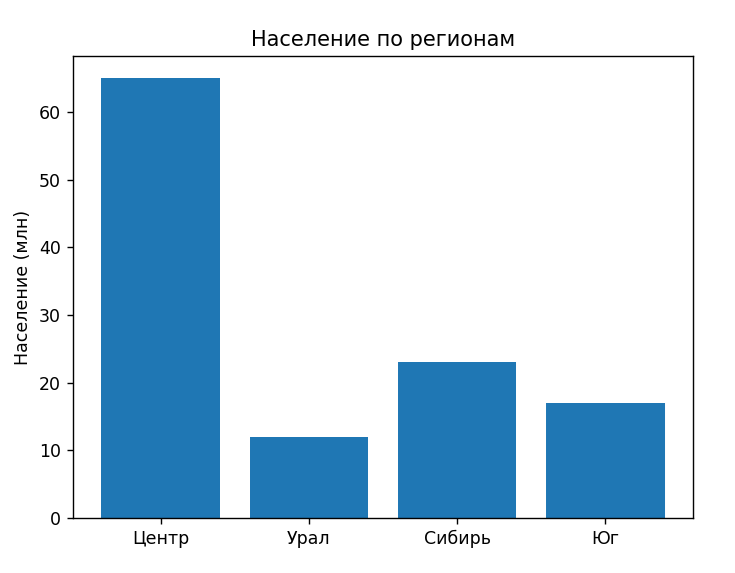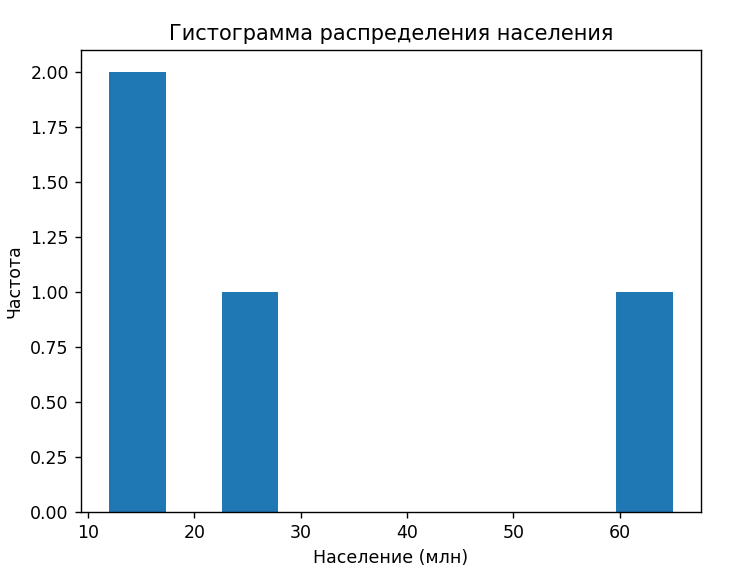12 KiB
Отчет по теме 4
Бережков Дмитрий, А-01-23
1.Начало работы, настройка текущего каталога
>>> import os
>>> os.chdir('C:\\MPEI\\PO_ASY\\BerezhkovGit\\python-labs\\Tema4')
2. Стандартные функции.
2.1 Функция round – округление числа с заданной точностью:
>>> help(round)
Help on built-in function round in module builtins:
round(number, ndigits=None)
Round a number to a given precision in decimal digits.
The return value is an integer if ndigits is omitted or None. Otherwise
the return value has the same type as the number. ndigits may be negative.
>>> round(123.456,1)
123.5
>>> round(123.456,0)
123.0
>>> type(round(123.456,0))
<class 'float'>
>>> round(123.456)
123
>>> type(round(123.456))
<class 'int'>
2.2 Функция range - создание последовательности целых чисел с заданным шагом или, по умолчанию, с шагом 1:
>>> gg=range(76,123,9)
>>> gg
range(76, 123, 9)
>>> list(gg)
[76, 85, 94, 103, 112, 121]
>>> range(23)
range(0, 23)
>>> list(range(23))
[0, 1, 2, 3, 4, 5, 6, 7, 8, 9, 10, 11, 12, 13, 14, 15, 16, 17, 18, 19, 20, 21, 22]
Объект с какими значениями получится в этом случае? Каковы границы диапазона? Какой шаг?
Значения: [0, 1, 2, 3, 4, 5, 6, 7, 8, 9, 10, 11, 12, 13, 14, 15, 16, 17, 18, 19, 20, 21, 22]
Границы: [0, 23)
Шаг: 1
2.3 Функция zip-создание общего объекта, элементами которого являются кортежи:
>>> qq=['Berezhkov','Stepanischev','Tabolin','Krishtul']
>>> ff=zip(gg,qq)
>>> fff = tuple(ff)
>>> print(fff)
((76, 'Berezhkov'), (85, 'Stepanischev'), (94, 'Tabolin'), (103, 'Krishtul'))
>>> print(len(fff))
4
>>> len(gg), len(qq)
(6, 4)
>>> ff[0]
Traceback (most recent call last):
File "<pyshell#34>", line 1, in <module>
ff[0]
TypeError: 'zip' object is not subscriptable
Невозможно обратиться с указанием индекса, потому что объект является итерируемым.
2.4 Функция eval– вычисление значения выражения:
>>> fff=float(input('коэффициент усиления=')); dan=eval('5*fff-156')
коэффициент усиления=3
>>> dan
-141.0
2.5 Функция exec – чтение и выполнение объекта-аргумента функции:
>>> exec(input('введите инструкции:'))
введите инструкции:perem=-123.456;gg=round(abs(perem)+98,3)
>>> gg
221.456
2.6 Функции abs, pow, max, min, sum, divmod, len, map:
>>> abs(-13)
13
>>> pow(2,4)
16
>>> max(42,54,33)
54
>>> min(1,3,5)
1
>>> sum([1,2,3])
6
>>> divmod(5,3)
(1, 2)
>>>
>>> len(range(9))
9
>>> r = map(lambda x: round(x) * (-1), [12.1245, 14.125234, 534.222])
>>> list(r)
[-12, -14, -534]
3. Функции из стандартного модуля math.
>>> import math
>>> dir(math)
['__doc__', '__loader__', '__name__', '__package__', '__spec__', 'acos', 'acosh', 'asin', 'asinh', 'atan', 'atan2', 'atanh', 'cbrt', 'ceil', 'comb', 'copysign', 'cos', 'cosh', 'degrees', 'dist', 'e', 'erf', 'erfc', 'exp', 'exp2', 'expm1', 'fabs', 'factorial', 'floor', 'fma', 'fmod', 'frexp', 'fsum', 'gamma', 'gcd', 'hypot', 'inf', 'isclose', 'isfinite', 'isinf', 'isnan', 'isqrt', 'lcm', 'ldexp', 'lgamma', 'log', 'log10', 'log1p', 'log2', 'modf', 'nan', 'nextafter', 'perm', 'pi', 'pow', 'prod', 'radians', 'remainder', 'sin', 'sinh', 'sqrt', 'sumprod', 'tan', 'tanh', 'tau', 'trunc', 'ulp']
>>> help(math.factorial)
Help on built-in function factorial in module math:
factorial(n, /)
Find n!.
Raise a ValueError if x is negative or non-integral.
>>> math.factorial(5)
120
3.1 Функции sin, acos, degrees, radians, exp, log, log10, sqrt, ceil, floor, pi:
>>> math.sin(90)
0.8939966636005579
>>> math.acos(0)
1.5707963267948966
>>> math.degrees(math.pi)
180.0
>>> math.radians(180)
3.141592653589793
>>> math.exp(4)
54.598150033144236
>>> math.log(10)
2.302585092994046
>>> math.log10(100)
2.0
>>> math.sqrt(16)
4.0
>>> math.ceil(3.14)
4
>>> math.floor(3.14)
3
>>> math.pi
3.141592653589793
3.2 Вычисление значения функции sin(2π/7+e0.23 ):
>>> math.sin((2*math.pi/7) + math.exp(0.23))
0.8334902641414562
4. Функции из модуля cmath:
>>> import cmath
>>> dir(cmath)
['__doc__', '__loader__', '__name__', '__package__', '__spec__', 'acos', 'acosh', 'asin', 'asinh', 'atan', 'atanh', 'cos', 'cosh', 'e', 'exp', 'inf', 'infj', 'isclose', 'isfinite', 'isinf', 'isnan', 'log', 'log10', 'nan', 'nanj', 'phase', 'pi', 'polar', 'rect', 'sin', 'sinh', 'sqrt', 'tan', 'tanh', 'tau']
>>> cmath.sqrt(1.2-0.5j)
(1.118033988749895-0.22360679774997896j)
>>> cmath.phase(1-0.5j)
-0.4636476090008061
5. Стандартный модуль random – совокупность функций для выполнения операций с псевдослучайными числами и выборками.
>>> import random
>>> dir(random)
['BPF', 'LOG4', 'NV_MAGICCONST', 'RECIP_BPF', 'Random', 'SG_MAGICCONST', 'SystemRandom', 'TWOPI', '_ONE', '_Sequence', '__all__', '__builtins__', '__cached__', '__doc__', '__file__', '__loader__', '__name__', '__package__', '__spec__', '_accumulate', '_acos', '_bisect', '_ceil', '_cos', '_e', '_exp', '_fabs', '_floor', '_index', '_inst', '_isfinite', '_lgamma', '_log', '_log2', '_os', '_parse_args', '_pi', '_random', '_repeat', '_sha512', '_sin', '_sqrt', '_test', '_test_generator', '_urandom', 'betavariate', 'binomialvariate', 'choice', 'choices', 'expovariate', 'gammavariate', 'gauss', 'getrandbits', 'getstate', 'lognormvariate', 'main', 'normalvariate', 'paretovariate', 'randbytes', 'randint', 'random', 'randrange', 'sample', 'seed', 'setstate', 'shuffle', 'triangular', 'uniform', 'vonmisesvariate', 'weibullvariate']
>>> help(random.seed)
Help on method seed in module random:
seed(a=None, version=2) method of random.Random instance
Initialize internal state from a seed.
The only supported seed types are None, int, float,
str, bytes, and bytearray.
None or no argument seeds from current time or from an operating
system specific randomness source if available.
If *a* is an int, all bits are used.
For version 2 (the default), all of the bits are used if *a* is a str,
bytes, or bytearray. For version 1 (provided for reproducing random
sequences from older versions of Python), the algorithm for str and
bytes generates a narrower range of seeds.
random.seed()
random.random() # вещественное число от 0.0 до 1.0
0.022635313373460364
random.uniform(5, 15) # вещественное число от 5.0 до 15.0
5.363612111162993
random.randint(1, 100) # целое число от 1 до 100
2
random.gauss(0, 1) # mu - среднее значение, sigma - стандартное отклонение
0.8104264223845308
random.choice([1, 2, 3, 4]) # случайный выбор элемента из списка, кортежа, строки и т.д.
1
Num = [1, 2, 3, 4]
random.shuffle(Num)
Num
[2, 1, 4, 3]
random.sample(Num, 2) # случайный выбор двух элементов из Num
[3, 1]
random.betavariate(2, 5) # случайное число с плавающей точкой на основе бета-распределения
0.3506592878950909
random.gammavariate(2, 1) # случайное число с плавающей точкой на основе гамма-распределения
3.755676054491517
6. Функции из модуля time – работа с календарем и со временем.
>>> import time
>>> dir(time)
['_STRUCT_TM_ITEMS', '__doc__', '__loader__', '__name__', '__package__', '__spec__', 'altzone', 'asctime', 'ctime', 'daylight', 'get_clock_info', 'gmtime', 'localtime', 'mktime', 'monotonic', 'monotonic_ns', 'perf_counter', 'perf_counter_ns', 'process_time', 'process_time_ns', 'sleep', 'strftime', 'strptime', 'struct_time', 'thread_time', 'thread_time_ns', 'time', 'time_ns', 'timezone', 'tzname']
>>> c1=time.time()
>>> c2=time.time()-c1
>>> c1
1761120933.7341516
>>> c2
5.980855703353882
>>> dat=time.gmtime()
>>> dat
time.struct_time(tm_year=2025, tm_mon=10, tm_mday=22, tm_hour=8, tm_min=16, tm_sec=5, tm_wday=2, tm_yday=295, tm_isdst=0)
>>> dat.tm_mon
10
>>> time.asctime((2025, 10, 13, 20, 13, 54, 1, 345, 0)) #год, месяц, день, час, минута, секунда, день недели, день года, летнее время
'Tue Oct 13 20:13:54 2025'
>>> time.ctime(time.time())
'Wed Oct 22 11:19:57 2025'
>>> time.mktime((2025, 12, 25, 15, 30, 0, 0, 0, 0))
1766665800.0
7. Графические функции.
>>> import pylab
>>> x=list(range(-3,55,4))
>>> t=list(range(15))
>>> pylab.plot(t,x) #Создание графика в оперативной памяти
[<matplotlib.lines.Line2D object at 0x000001890FC94910>]
>>> pylab.title('Первый график')
Text(0.5, 1.0, 'Первый график')
>>> pylab.xlabel('время')
Text(0.5, 0, 'время')
>>> pylab.ylabel('сигнал')
Text(0, 0.5, 'сигнал')
>>> pylab.show() #Отображение графика на экране
Отображение графика:

>>> X1=[12,6,8,10,7]; X2=[5,7,9,11,13]
>>> pylab.plot(X1)
[<matplotlib.lines.Line2D object at 0x000001890FD35450>]
>>> pylab.plot(X2)
[<matplotlib.lines.Line2D object at 0x000001890FD35590>]
>>> pylab.show()
Отображение графика:

>>> region=['Центр','Урал','Сибирь','Юг'] #Метки для диаграммы
>>> naselen=[65,12,23,17] # Значения для диаграммы
>>> pylab.pie(naselen,labels=region) #Создание диаграммы в памяти
([<matplotlib.patches.Wedge object at 0x000001890E333E00>, <matplotlib.patches.Wedge object at 0x000001890F4DF110>, <matplotlib.patches.Wedge object at 0x000001890F4DF4D0>, <matplotlib.patches.Wedge object at 0x000001890F4DF750>], [Text(-0.191013134139045, 1.0832885038559115, 'Центр'), Text(-0.861328292412156, -0.6841882582231001, 'Урал'), Text(0.04429273995539947, -1.0991078896938387, 'Сибирь'), Text(0.9873750693480946, -0.48486129194837324, 'Юг')])
>>> pylab.show() #Отображение диаграммы
Отображение диаграммы:

>>> pylab.bar(region, naselen)
<BarContainer object of 4 artists>
>>> pylab.title('Население по регионам')
Text(0.5, 1.0, 'Население по регионам')
>>> pylab.ylabel('Население (млн)')
Text(0, 0.5, 'Население (млн)')
>>> pylab.show()
Отбражение диаграммы:

>>> pylab.hist(naselen)
(array([2., 0., 1., 0., 0., 0., 0., 0., 0., 1.]), array([12. , 17.3, 22.6, 27.9, 33.2, 38.5, 43.8, 49.1, 54.4, 59.7, 65. ]), <BarContainer object of 10 artists>)
>>> pylab.title('Гистограмма распределения населения')
Text(0.5, 1.0, 'Гистограмма распределения населения')
>>> pylab.xlabel('Население (млн)')
Text(0.5, 0, 'Население (млн)')
>>> pylab.ylabel('Частота')
Text(0, 0.5, 'Частота')
>>> pylab.show()
Отображение гистограммы:

8. Статистический модуль statistics.
>>> import statistics
>>> numbers = [1,2,3,4,5,6,7,8,9]
>>> statistics.mean(numbers)
5
>>> statistics.median(numbers)
5
>>> a = [-1,-2,-3,-4,-5,-6,-7,-8,-9]
>>> statistics.correlation(numbers, a)
-1.0